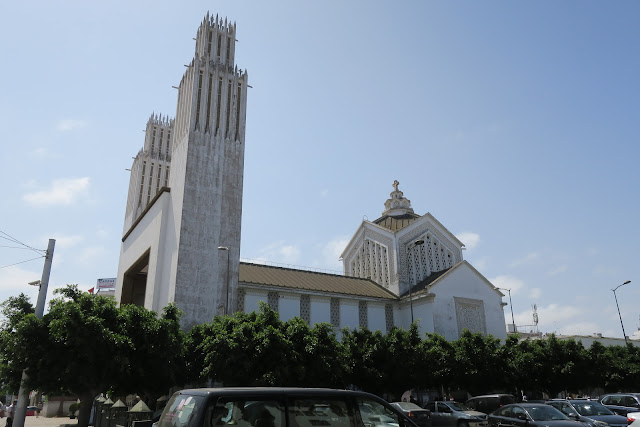Rabat is another place on the Atlantic coast which has a less than well known history. It has a twin town, Salé, across the river Bou Regreg, .The Romans and Phoenicians knew the river as far back as the 8th century B.C. The Roman name for the town was Sala Colonia. This later became Chellah, and the Berbers built a fortress/ monastery or Ribat on the site of the present Kasbah. Spanish influence was apparent from the 12th century as Andalucia was brought back under Muslim rule. Rabat became briefly an imperial capital, Ribat Al Fatah, under the Alomad ruler Yacoub Al-Mansour. Extensive walls were built including the Bab Oudaia to the Kasbah, seen below. He also began the construction of a vast mosque which was never completed. We would get to see this another day.
Later in the 17th century Salé, Rabat became a centre for piracy, these corsairs were known, along with other centres in North Africa as being Barbary Corsairs, or Sallee Rovers. Ranging from North America to southern Ireland and Cornwall seeking white Christian slaves. The piracy trade was good and lasted well into the 19th century. The Sallee Rovers are mentioned in the novel Robinson Crusoe, the hero spends some time in captivity before sailing off to liberty from the Salé ( Bou Regreg ) river. We got a good view of the river entrance from the "Plateforme du semaphore" (signal Station )
To be honest the entrance to the river is less than inviting today, at low water sandbars and a considerable swell make the entrance tricky. As we walked to the far end of the Kasbah to look out at the sea from the walls it became apparent that both Salé and Rabat were surrounded by graveyards. Where Lynne is looking in the photo above at the back of the beach along its full length are graves, as is the area below us. It would appear the dead are buried outwith the walls, although I can find no mention of this fact anywhere so far.
After a quick explore of the Kasbah and avoiding the inevitable "guide" offering to show us around we retired to the Andalucian Gardens. These are within the Kasbah walls and are a haven of peace tranquility and cats.
They are also free to visit which is always a bonus. Its a pity that you cant capture smells on a photograph, as the herbs and plants along with some lovely blooms are delightful, unlike some other parts of the Medina. As you walk around it becomes apparent that drains are usually covered by cardboard or a mat, presumably to lessen the olfactory assault!
As we are within the ancient walls the colours of the dried mud and plaster walls contrasts quite nicely against the greenery and does highlight the colourful paintwork decorating most woodwork. as above.
All in all a delightful spot, and that's before you are enticed to stop and smile at the resident cat colony.
This is a seemingly constant theme in Morocco, Feral cats are cossetted, fed and generally looked after almost everywhere. We have our own cat characters around the marina in Tangiers. It is difficult to not smile and stop a while when six new born kittens are wrestling in the dust.
If you look very carefully at the walls surrounding the gardens you may come across a small door which leads you outside the walls to a famous cafe. The cafe Maure. Its just to the right of Lynne in the photo below.
This is a delightful spot to sit and watch the river below, with extensive views across to Salé. Mint tea is the only game in town here so if your preference is coffee you will need to look elsewhere. Pastries are available from the specialised seller who will come around carrying a large tray of goodies.
There is also a direct entrance back into the Kasbah, this is interesting to wander around and as we were early on this particular day we avoided the "hard sell" from the vendors. There are some lovely bits of random art in the decorated doors and woodwork. An example below.
Later we left the Medina to buy our return tickets from the train station. The New town outside the medina walls was largely designed as a "new town" and has wide boulevards and shady tree lined verges. This is the main street, the Avenue Mohammed V.
It leads to the main Mosque and also the railway station Rabat Ville. Which along with a great deal of the railway system is being rebuilt and refurbished . There will soon be a new high speed line TGV, between Tangiers and Casablanca. There has been a great deal of European investment in |Moroccan infrastructure, for which the present King takes great deal of credit.
Before we returned to the old town we had a look at the Cathedral of St pierre, built in 1919 with the addition of the two art deco towers in 1930.
Its certainly a striking building and is dazzlingly white in the sun, however despite several revisits at advertised times we never found it open so were unable to look inside. I think it would have been quite lovely looking at the stained glass from the outside.
As Rabat is the capital of Morocco I can see why a Cathedral is located here but I wonder how much it is actually patronised in a country that is 99% Muslim. A white elephant maybe?















No comments:
Post a Comment